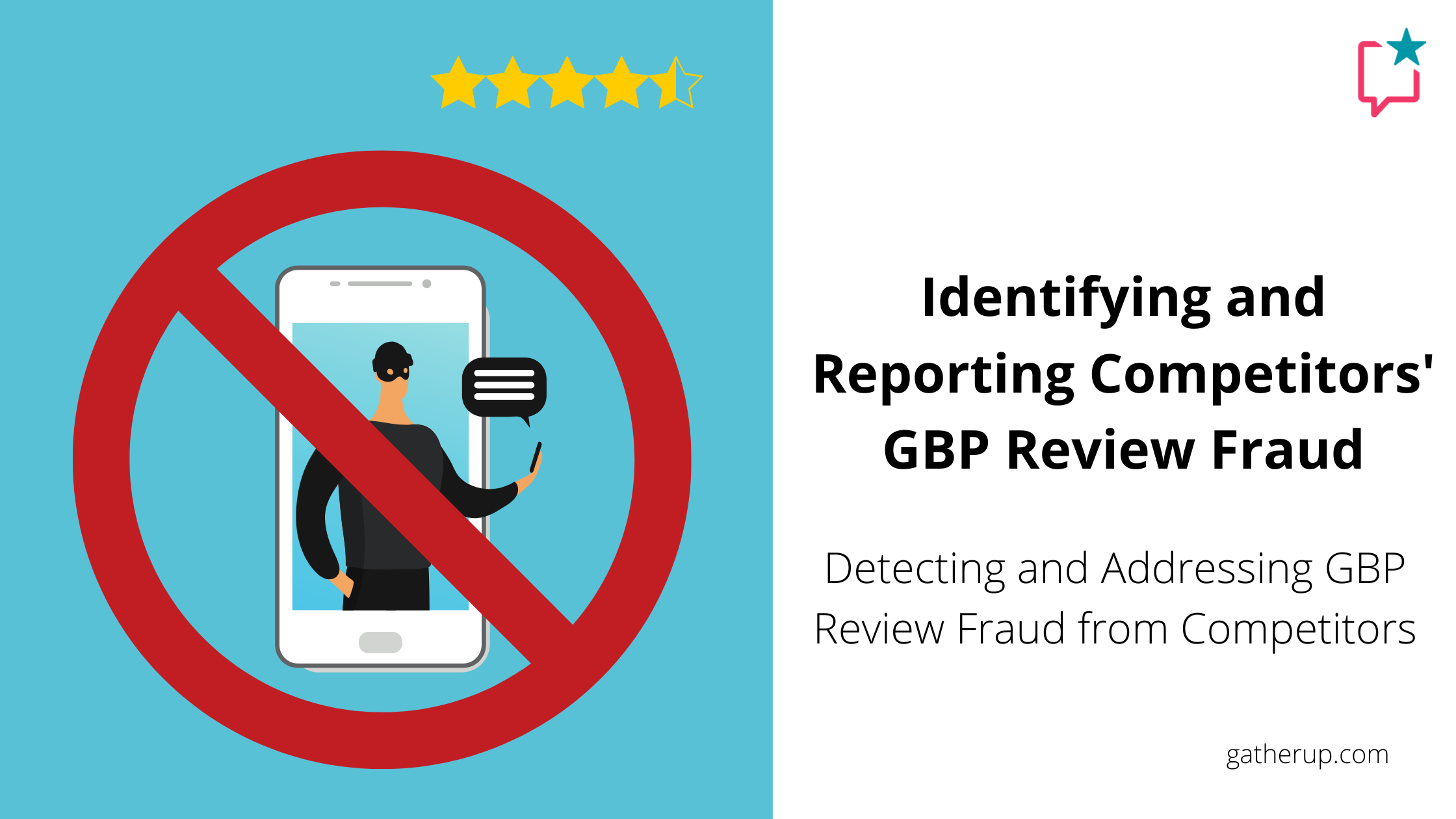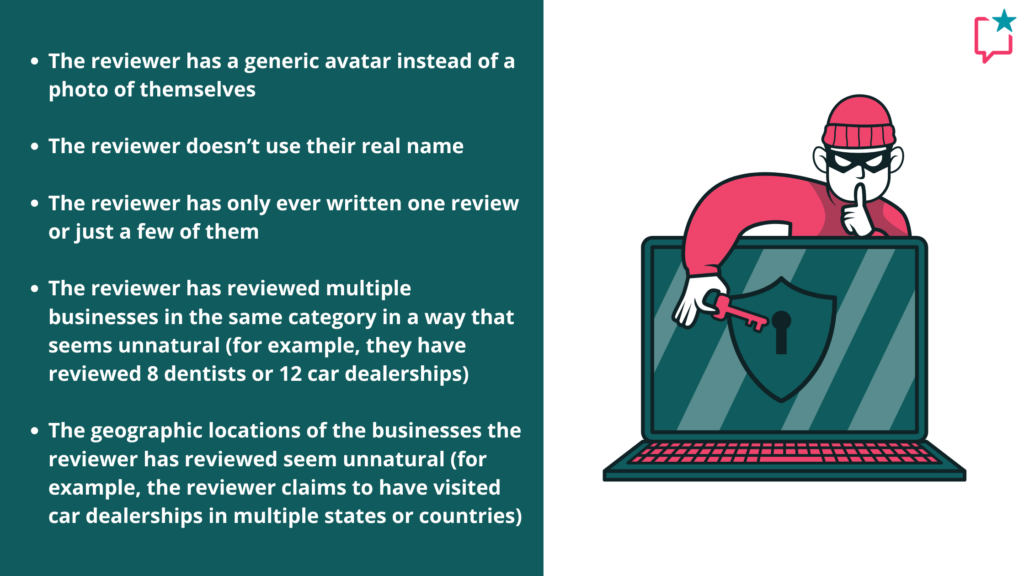
I want to spend a few useful minutes today helping you learn to recognize and report your nearby competitors when they are almost certainly engaging in review fraud on their Google Business Profiles (GBPs).
Let’s start with three questions that may be at the front of your mind:
- Why is knowing how to do this more important than ever before?
Because review fraud is going off the charts and is about to get much worse. A few weeks ago, I interviewed Curtis Boyd of the Transparency Company and Greg Sterling of Near Media about a joint study they conducted which found that:
- Some 14% of reviews in just 3 industries (home services, legal, and medical) are very likely fake. 14% may not sound like a lot until you understand it represents millions of spam reviews.
- This works out to consumers suffering $300 billion in economic harm, in just these three industries, meaning that your neighbors are regularly being scammed.
- Due to the phenomenon-nobody-wanted of AI now being used to generate review spam, Boyd and Sterling estimate that GBPs could be featuring more fake reviews than real ones as soon as the end of 2026.
That last point is a big red flag that the already-monstrous problem of your competitors spamming their way into Google’s results and consumers’ trust is only going to get worse over the next couple of years. It’s time to hone your review spam-fighting skills today, because your local brand is going to need them more than ever before.
- But, wait, shouldn’t it be up to Google to clean up their own review spam mess?
In a perfect world, yes, and Google does release statements from time to time announcing that they have removed a number of fake reviews. These efforts are important, but the truth is that they simply aren’t enough to take on the massive scale of review spam. Boyd and Sterling’s findings in the three verticals they’ve investigated show just how polluted the GBP system is with spam and how much money consumers are losing to bad actors, despite Google’s attempts to combat review fraud.
The best way I can suggest you think about this is that it is your business and your service community that are being harmed by review fraud, and no one is going to care as much about the place you live and work as you do. Our own major review study found that 99% of US consumers consult local business reviews before choosing a nearby company and that 85% feel some degree of trust in them. Real people rely on this content, and, quite frankly, Google appears to be overwhelmed by this problem of the system they’ve created. The truth is that you have a very personal stake in trying to protect yourself and your neighbors from unfair competition and downright scams. Too much can go wrong if you wait for Google to take full responsibility for their product.
- Darn it all, I’m an honest and very busy business owner – why should I have to cope with this shady scenario?
It does rather feel like finding mouldy oranges in your refrigerator, having to wade into the world of review spam – yuck! But know you’re in the same boat as all other legitimate business owners in this regard. You may have to hold your nose while you fish out the rotten fruit and then wash your hands afterwards, but you are definitely not alone in trying to discover and draw Google’s attention to spoilage in their system.
Business owners who have built their brands around fair practices and sincere care for their communities may find it incredibly distasteful to go hunting for review spam in their hometowns. If this describes your feelings, there’s always the option of bringing in pros for help with the dirty work. However you decide to proceed, being able to spot a fake review yourself is still a good, basic skill to have in our digital age.
How to spot 6 signs of GBP review fraud
Scammers engage in both personal and hired review fraud with the goals of outranking legitimate competitors, promoting their own schemes, and fooling the public. Be on the lookout for these six red flags of potential review fraud:
- Suspicious review velocity
If a business you’re keeping an eye on in your local market suddenly goes from having very few reviews to having a large number of them over the course of a few days or weeks, pay attention. It could be perfectly innocent; they may simply have initiated or re-launched an authentic review acquisition program. On the other hand, if aspects of the reviews look suspicious, you may have cause for concern. Read on.
- Suspicious reviewer profiles
If you suspect that one or more of your competitor’s reviews might be fake, click on the profile icon of each relevant reviewer to see further details about them and their contributions to Google’s system. Note whether you see any of following signals of potential untrustworthiness:

- Suspicious review language
This comes in several flavors, including:
- The reviewer states that they are the owner or a present or past employee of the business (this type of review is prohibited in Google’s system).
- Review language indicates that the reviewer has never interacted with the business (this is a common phenomenon when a negative news story emerges about a business and non-customers leave negative reviews in droves, but it can also happen that reviewers will state something along the lines of “I’ve never visited this business, but I heard it was bad.”) Neither type of review is allowed in Google’s system.
- Review language greatly praises business owners/staff by name. This can often be legitimate, as in the case of a patron taking note of an extra-helpful waiter’s name at the time of service, and then mentioning them in their subsequent review. However, be on the lookout for phrases like, “Jim Johnson and his partner Bob Jones are the best garage door repair professionals in Santa Fe, New Mexico and the world!”
- Review language speaks negatively of one business while praising its competitor. For example, you might see that the same review profile has reviewed multiple locksmith businesses, singling out just one for praise while leaving reviews for nearby competitors that read something along the lines of, “don’t go here, go to X business instead.”
- Review language questions the high-star reviews others have left. For example, a review might read, “I don’t know why Joe S. has given this restaurant a 5-star review. It only deserves 3 stars.”
- Even more suspicious review language, thanks to AI
Due to AI’s ability to generate countless fake reviews on demand, we must now be on the lookout for robotic-sounding language that makes us ask, “Would a human being actually write this way?”
In speaking with Boyd and Sterling, I learned that a phrase to be on the lookout for is:
“I recently had the pleasure of working with…”
- Suspicious images in reviews
Images can be one of the strongest signals that a consumer has legitimately interacted with a local business. But look again. Do you see reviews containing photographs that look like they came from a manufacturer or which match or strongly resemble the professional photography on the company’s own website? This can be a tough one, because our phones all take very good pictures these days. Nevertheless, I would encourage you to pay attention to review-based imagery which feels “off” to you – as though it is coming across as the business advertising itself instead of random customers taking pics.
- Suspicious review takedown patterns
If you are closely monitoring specific competitors and have seen Google remove significant numbers of these businesses’ reviews in the past (apparently due to spam rather than bugs), you have good reason to keep an eye on them. Some scammers never learn, even after being punished with review removals and listing penalties, and they will continue to spam Google’s system in their efforts to get ahead. If you’ve identified known spammers in your market, you have the option of watchdogging their activities and reporting obvious guideline violations to Google.
How to report review spam
There are two things you need to have in your back pocket before you engage in spam fighting:
Google’s Prohibited & Restricted Content Guidelines, which lay out what they consider to be spam vs. what is allowable in their system. You will get nowhere trying to report suspicious reviews if they don’t clearly violate a guideline.
Realistic expectations. This can be very frustrating, but you need to engage in spam fighting with the understanding that Google may not remove reviews even when they are in obvious violation of their guidelines. Google does not guarantee spam review removal, meaning that your investment in reporting fraud should be thought of as your best effort to protect your business and community, rather than as an activity that will always yield the desired results.
There are also two different scenarios inherent to review fraud: your business being directly targeted with spam reviews to harm your listings and your competitors engaging in fake reviews of their own businesses to promote their listings. We’ll now look at how to report Google Business Profile reviews in both cases.
When you are the victim of review spam
Take the following steps:
Sign into your Google account that controls the relevant Google Business Profile.
Type “my business” into Google’s search box. This should bring up the New Merchant Experience (NMX) dashboard within Google’s organic results.
Click on the “Read reviews” icon in the NMX. Find the suspicious review you want to report.
Click the three dots next to the suspicious review and then click the “Report review” option. You will then be able to flag that review for removal.
Wait 3 days. Don’t do anything else with the suspicious review during the 3 days.
Check the status of your report via the Google Review Tool. In the tool, search for the name of your business in the “listing name” field. Click the radio button for “check the status of a review I reported previously”, and Google will then tell you whether their decision is still pending, or that they don’t believe the review violates their policy, or that they have removed the review.
If Google has refused to remove the review, click the “appeal eligible reviews” radio button. This will take you to a field for providing further information to Google about why you think a review violates their policy. Once you submit this, you’ll receive a case ID via email which you should hang onto. Within a few days or weeks, you should receive Google’s final decision. If your request is again denied, you unfortunately cannot submit another appeal.
Hopefully, this 7-step process will have resulted in the spam review being removed. If not, there are 4 options left to you:
- You could consider taking your case ID and evidence to the Google Business Profile Help Community. The volunteer Product Experts who moderate this forum do not have any power to remove reviews, but if your post there convinces them that Google may have made a mistake in refusing to take down a spam review, they may be able to escalate your case. However, do not take the step of going public with review spam lightly. By posting in the GBP Help Community, you are making a public accusation of fraud against another individual or company. This could potentially lead to a lawsuit. Carefully evaluate whether further pursuit of spam review removal is worth the risk of litigation.
- You could engage legal counsel. If you’ve been able to identify the real-world individual or entity attacking your GBP with review fraud, an attorney may be able to help you understand your further options in the absence of Google removing the problem content. It could be that your lawyer might file a cease-and-desist notice or suggest other steps, based on your individual case.
- My best practice advice is not to respond to fake reviews while you are in the process of trying to flag them. Just leave them alone until you have a final decision from Google. At that point, however, if Google has made it clear that they will not remove the fraudulent content, you could use the owner response field to state, “We have reported this review to Google for potential guideline violations.” You don’t need to provide any other details; this brief note could help alert the public that the review may not be credible, potentially reducing the impact it may have on their impression of your brand’s reputation.
- Let it go and earn some new positive reviews. Every brand receives a certain percentage of negative reviews. If your best efforts don’t result in fake review removal, you can choose to walk away and try to put the bad experience behind you by focusing on earning new positive, genuine reviews.
When your competitor is engaging in apparent review spam
If your competitor appears to be engaging in activities like purchasing or publishing fake reviews to promote themselves, take the following steps:
Look up the business in Google and click on the blue review count link on their Google Business Profile (see 931 Google reviews example, above).
Again, click the three dots next to the suspicious review, and click “Report review”.
You will then be given a substantial menu of issues that are causing you to report the review. It might be that you can prove there is a conflict of interest, for example, or that the review is spam.
Once you’ve chosen the menu option that best fits your scenario, click on it and you will be taken to a final screen to submit. You can watch your competitor’s profile to see if the review disappears.
This is the simplest process for reporting a single suspected spam review. However, there are many cases in which businesses realize that someone in their market is engaging in widespread review spam. Again, you have the option of taking to the Google Business Profile Help Community with documentation of what you are seeing, but this does carry legal risks that you should weigh carefully. Instead of going public, you might try privately contacting Google Business Profile Support via this form to alert them to the problem, including any evidence you’ve documented. Another option would be to hire a seasoned local SEO for a consultation to see if they have professional advice or might be willing to go public with the story on their own media channels to bring Google’s attention to it.
A couple of years ago, local SEO Phil Rozek reported that his efforts at reporting entire GBPs in violation of Google’s guidelines met with about a 60% success rate. I don’t have similar data for reporting fake reviews, but I would not be surprised if it was lower. Being a realist when it comes to reputation management in Google’s system means setting fairly low expectations, but when successes occur, they are almost always worth it.
A final note
The more complex your business model, the more time you will need to invest in the various aspects of online reputation management, including review spam detection and fighting. A suspicious negative review here or there is par for the course and can be quickly reported, potentially removed, or eventually pushed down by fresher incoming reviews. This is review management at its simplest.
The scenario is quite different when we move into the territory of multi-location businesses with large volumes of user generated content to manage. Professional systems need to be put in place to evaluate reviews at scale, to analyze them, and to catch as much spam as possible for reporting.
The predictable disaster which AI review generation is bringing to this space only exacerbates existing weaknesses in the GBP system and highlights the urgent need for improved review management tech. I’ll have more to say on this soon, but in the meantime, let me wish you good luck in tough markets in which spammers have been allowed to gain the upper hand. Local businesses and the communities they serve deserve so much better.
